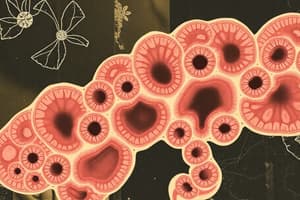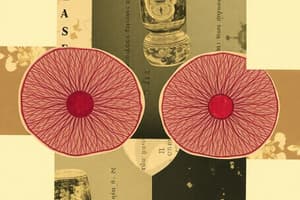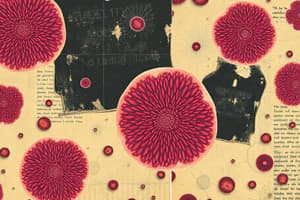Podcast
Questions and Answers
Which type of epithelium is primarily involved in covering and protecting surfaces, diffusion, and absorption?
Which type of epithelium is primarily involved in covering and protecting surfaces, diffusion, and absorption?
- Sensory epithelium
- Myoepithelium
- Covering epithelium (correct)
- Glandular epithelium
What is the main function of myoepithelium?
What is the main function of myoepithelium?
- Contractility (correct)
- Secretion
- Excretion
- Sensation
Secretion via exocytosis, excluding metabolic wastes, is characteristic of which type of epithelium?
Secretion via exocytosis, excluding metabolic wastes, is characteristic of which type of epithelium?
- Sensory epithelium
- Myoepithelium
- Glandular epithelium (correct)
- Covering epithelium
Epithelial cells specialized to produce secretion are classified as which of the following?
Epithelial cells specialized to produce secretion are classified as which of the following?
What distinguishes endocrine glands from exocrine glands?
What distinguishes endocrine glands from exocrine glands?
How do endocrine glands secrete their products?
How do endocrine glands secrete their products?
What structural feature is absent in endocrine glands, which is typically present in exocrine glands?
What structural feature is absent in endocrine glands, which is typically present in exocrine glands?
Which of the following describes how exocrine glands release their secretions?
Which of the following describes how exocrine glands release their secretions?
Exocrine glands can be classified based on several criteria. Which of the following is NOT a criterion for classifying exocrine glands?
Exocrine glands can be classified based on several criteria. Which of the following is NOT a criterion for classifying exocrine glands?
Multicellular exocrine glands can be further divided into two categories based on duct structure. What are these categories?
Multicellular exocrine glands can be further divided into two categories based on duct structure. What are these categories?
What is a key characteristic of unicellular exocrine glands?
What is a key characteristic of unicellular exocrine glands?
Which type of unicellular gland is most commonly found secreting mucus?
Which type of unicellular gland is most commonly found secreting mucus?
In the context of multicellular glands, what distinguishes the proximal part from the distal part?
In the context of multicellular glands, what distinguishes the proximal part from the distal part?
Considering the classification of exocrine glands based on duct structure, what feature defines a "simple" gland?
Considering the classification of exocrine glands based on duct structure, what feature defines a "simple" gland?
If a gland is described as tubuloalveolar, what does this indicate about its structure?
If a gland is described as tubuloalveolar, what does this indicate about its structure?
Which of the following is an example of a simple tubular gland?
Which of the following is an example of a simple tubular gland?
Which of the following glands is classified as a compound acinar gland?
Which of the following glands is classified as a compound acinar gland?
In which mode of secretion does the cell lose a small part of its cytoplasm along with the secretory product?
In which mode of secretion does the cell lose a small part of its cytoplasm along with the secretory product?
If a gland secretes its products without affecting the well-being of the cell, which mode of secretion is it using?
If a gland secretes its products without affecting the well-being of the cell, which mode of secretion is it using?
In holocrine secretion, what happens to the cell?
In holocrine secretion, what happens to the cell?
Mammary glands utilize which mode of secretion?
Mammary glands utilize which mode of secretion?
Which of the following is an example of a gland that utilizes merocrine secretion?
Which of the following is an example of a gland that utilizes merocrine secretion?
What primary characteristic defines serous glands?
What primary characteristic defines serous glands?
How do serous glands typically stain with H/E stain?
How do serous glands typically stain with H/E stain?
In mucous glands, where are the nuclei typically located within the cell?
In mucous glands, where are the nuclei typically located within the cell?
What staining characteristic is typical of mucous glands when using H/E stain?
What staining characteristic is typical of mucous glands when using H/E stain?
Which feature characterizes mixed glands?
Which feature characterizes mixed glands?
What are serous demilunes and where are they typically found?
What are serous demilunes and where are they typically found?
Which of the following is a function of covering epithelium?
Which of the following is a function of covering epithelium?
What distinguishes exocrine glands from endocrine glands in terms of their cellular structure and arrangement?
What distinguishes exocrine glands from endocrine glands in terms of their cellular structure and arrangement?
If a gland is classified as "compound tubuloacinar," what implications does this have for its structure?
If a gland is classified as "compound tubuloacinar," what implications does this have for its structure?
Sebaceous glands secrete sebum using what type of secretion?
Sebaceous glands secrete sebum using what type of secretion?
Considering the structural components of multicellular glands, how does the acinus contribute to gland function?
Considering the structural components of multicellular glands, how does the acinus contribute to gland function?
In the context of secretory mechanisms, what primarily differentiates serous glands from mucous glands in terms of their products and staining properties?
In the context of secretory mechanisms, what primarily differentiates serous glands from mucous glands in terms of their products and staining properties?
A gland presents crescent-shaped structures on mucous acini. What cell type would you expect to be predominant in these structures and what is this arrangement known as?
A gland presents crescent-shaped structures on mucous acini. What cell type would you expect to be predominant in these structures and what is this arrangement known as?
Flashcards
Covering Epithelium
Covering Epithelium
Epithelium whose main function is to cover and protect surfaces.
Diffusion (Epithelium)
Diffusion (Epithelium)
Epithelium that facilitates the movement of substances across cell membranes.
Absorption (Epithelium)
Absorption (Epithelium)
Epithelium specialized for taking in substances.
Excretion (Epithelium)
Excretion (Epithelium)
Signup and view all the flashcards
Secretion (Epithelium)
Secretion (Epithelium)
Signup and view all the flashcards
Sensory Epithelium
Sensory Epithelium
Signup and view all the flashcards
Myoepithelium
Myoepithelium
Signup and view all the flashcards
Glandular Epithelium
Glandular Epithelium
Signup and view all the flashcards
Endocrine Glands
Endocrine Glands
Signup and view all the flashcards
Exocrine Glands
Exocrine Glands
Signup and view all the flashcards
Unicellular Glands
Unicellular Glands
Signup and view all the flashcards
Multicellular Glands
Multicellular Glands
Signup and view all the flashcards
Simple Gland
Simple Gland
Signup and view all the flashcards
Compound Gland
Compound Gland
Signup and view all the flashcards
Merocrine Secretion
Merocrine Secretion
Signup and view all the flashcards
Apocrine Secretion
Apocrine Secretion
Signup and view all the flashcards
Holocrine Secretion
Holocrine Secretion
Signup and view all the flashcards
Serous Glands
Serous Glands
Signup and view all the flashcards
Mucous Glands
Mucous Glands
Signup and view all the flashcards
Mixed Glands
Mixed Glands
Signup and view all the flashcards
Secretion by Exocytosis
Secretion by Exocytosis
Signup and view all the flashcards
Covering Function
Covering Function
Signup and view all the flashcards
Alveolar (Acinar) Gland
Alveolar (Acinar) Gland
Signup and view all the flashcards
Secretory Cells
Secretory Cells
Signup and view all the flashcards
Study Notes
- Function and types of epithelium: Epithelium can cover and protect surfaces, aid in diffusion and absorption, excretion, secretion, sensation, and contractility.
- Covering epithelium is involved in covering and protecting surfaces, diffusion, and absorption.
- Glandular epithelium is involved in excretion and secretion.
- Sensory epithelium is involved in sensation.
- Myoepithelium is involved in contractility.
Glandular Epithelium
- Epithelial cells are specialized to produce secretions.
- Secretion is the exocytotic release of products and does not include metabolic wastes.
- Molecules to be secreted are stored in membrane-bound secretory granules.
Classification of Glands
- Glands are classified as endocrine and exocrine, depending on their route of secretion.
- Exocrine and endocrine gland formation begins with the proliferation of cells in the epithelium.
- This is followed by the downgrowth into the subjacent connective tissue.
- A basal lamina and connective tissue underlie the epithelium.
- Exocrine gland formation involves invagination from the epithelial layer whereas endocrine gland formation involves cords of cells forming the endocrine gland.
- Disappearance of duct cells occurs in endocrine gland formation
- Both exocrine and endocrine gland formations have secretory portions and capillaries nearby.
Endocrine Glands
- Endocrine glands secrete hormones directly into the bloodstream.
- Endocrine glands do not have ducts.
Exocrine Glands
- Exocrine glands can be classified according to: the number of cells, the mode of secretion, the shape, and produced secretory products.
- Regarding the number of cells, exocrine glands can be unicellular or multicellular.
- Regarding the mode of secretion, exocrine glands can be holocrine, apocrine, or merocrine.
- Regarding to shape, exocrine glands can be tubular, alveolar (acinar), or tubuloalveolar.
- Regarding secretory products, exocrine glands can be mucous and serous.
Classification by Cell Number
- Unicellular glands consist of single cells, whereas multicellular glands consist of multiple cells.
- Multicellular glands can be simple with one unbranched duct or compound with branched ducts.
- A simple multicellular gland example: sweat gland.
- A compound multicellular gland example: parotid gland.
Unicellular Glands
- Unicellular glands are scattered among other non-secretory epithelial cells.
- They lack ducts and secrete their products directly onto the free surface.
- Goblet cells, which secrete mucus, are the most common type of unicellular exocrine glands.
- Goblet cells are single cells distributed among non-secretory cells.
- Goblet cells are found in the trachea and small intestine.
Multicellular Glands
- Multicellular glands are formed by invagination of the epithelial layer in deeper tissue, forming a diverticulum.
- The proximal part forms the duct, while the distal part forms the secretory element.
Exocrine vs. Endocrine
- Exocrine glands pour their secretions onto an epithelial surface, either directly or through ducts.
- Endocrine glands (ductless) pour their secretions directly into the blood.
- Exocrine glands release secreted substances through a duct to a digestive tract or outside of the body whereas endocrine glands release hormones into the extracellular fluid that flow into the capillaries.
Classification by Duct Shape and Branching
- Classification is based on the shape of secretory units (tubular or alveolar) and branching patterns.
- There are two types: simple and compound.
- Examples of simple glands include simple tubular, simple coiled tubular, simple branched tubular, and simple branched alveolar.
- Examples of compound glands include compound tubular, compound alveolar, and compound tubulo-alveolar.
- Examples of simple glands are alveolar (acinar), tubular, and tubulo-alveolar.
Examples of Glands
- Simple tubular glands include crypt of Lieberkuhn.
- Simple coiled tubulars include sweat glands.
- Simple branched tubular glands include fundic glands of the stomach.
- Simple branched acinar include meibomian glands.
- Compound tubulars include Brunner glands.
- Compound tubuloacinar include submandibular glands.
- Compound acinar glands include mammary glands.
Modes of Secretion
- Modes of secretion describe how products leave the cell.
- There are three primary modes of secretion: merocrine, apocrine, and holocrine.
- Merocrine secretion does not affect the well-being of the cell. A few examples are sweat glands, salivary glands, and pancreas.
- Apocrine secretion involves a small part of the cell cytoplasm being lost with the secretion; an example is mammary glands.
- Holocrine secretion involves a great deal of cytoplasm being lost with the secretion; the cell dies, as seen in sebaceous glands.
- Merocrine secretion is secretion by exocytosis. Vesicles fuse with the plasma membrane and release their contents.
Apocrine Secretion
- An illustration of apocrine secretion shows pinched-off portions of cells released as the secretion in the mammary gland.
Holocrine Secretion
- In holocrine secretion, disintegrating cells and their contents are released as secretions, as seen in sebaceous glands.
Classification by Nature of Secretion
- Glands can be classified based on the nature of their secretion: serous, mucous, and mixed.
Serous Glands
- Serous glands secrete a thin, watery substance rich in enzymes and protein.
- The cytoplasm of serous glands is granular, staining darkly from pink to dark purple with H/E stain, due to being rich in rough endoplasmic reticulum (rER).
- Serous glands have rounded and basally placed nuclei.
Mucous Glands
- Mucous glands secrete mucopolysaccharides, which accumulate in the apical part of the cell.
- The cytoplasm of mucous glands stains very lightly with H/E stain, giving an empty look.
- Mucous glands have basally placed and flattened nuclei due to the mucoid pushing the nuclei.
Mixed Glands
- Mixed glands contain both serous and mucous secretory units.
- Serous cells sometimes form crescentic caps, or serous demilunes, on mucous acini.
Studying That Suits You
Use AI to generate personalized quizzes and flashcards to suit your learning preferences.



